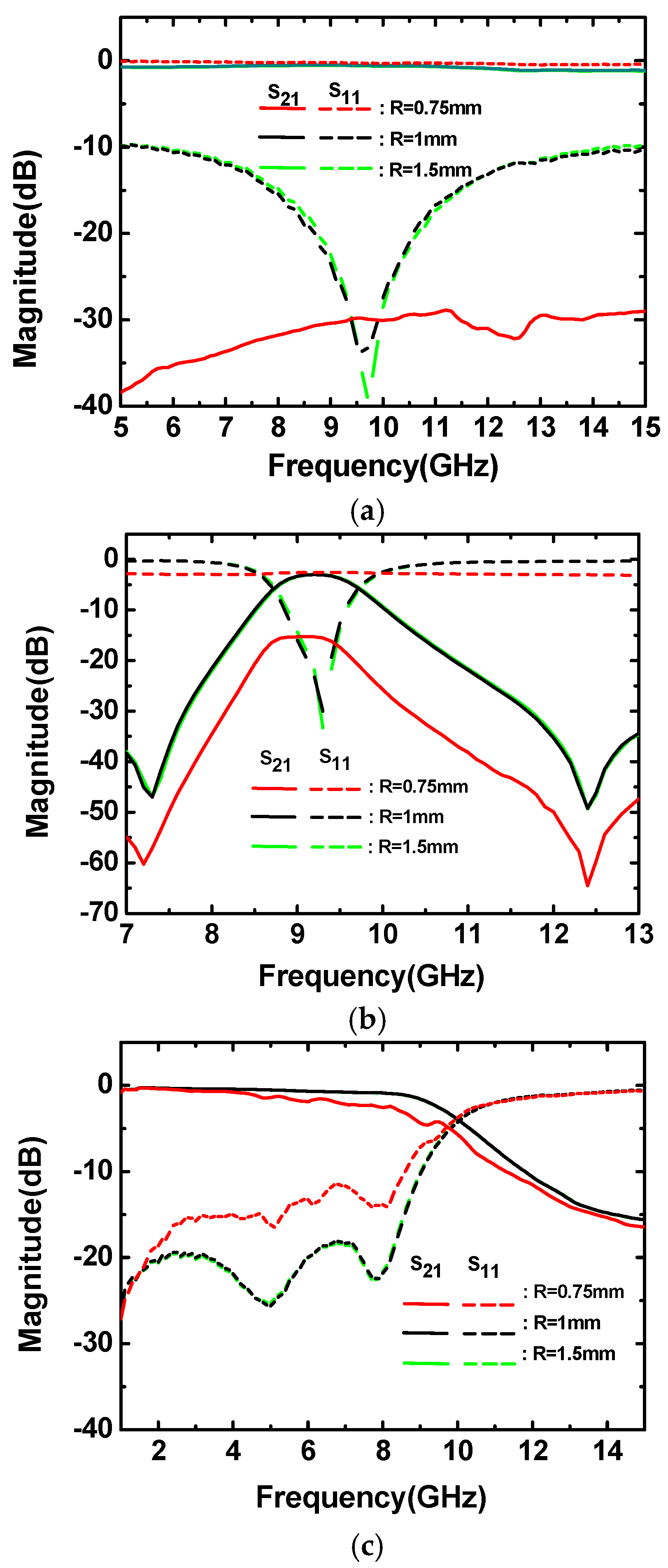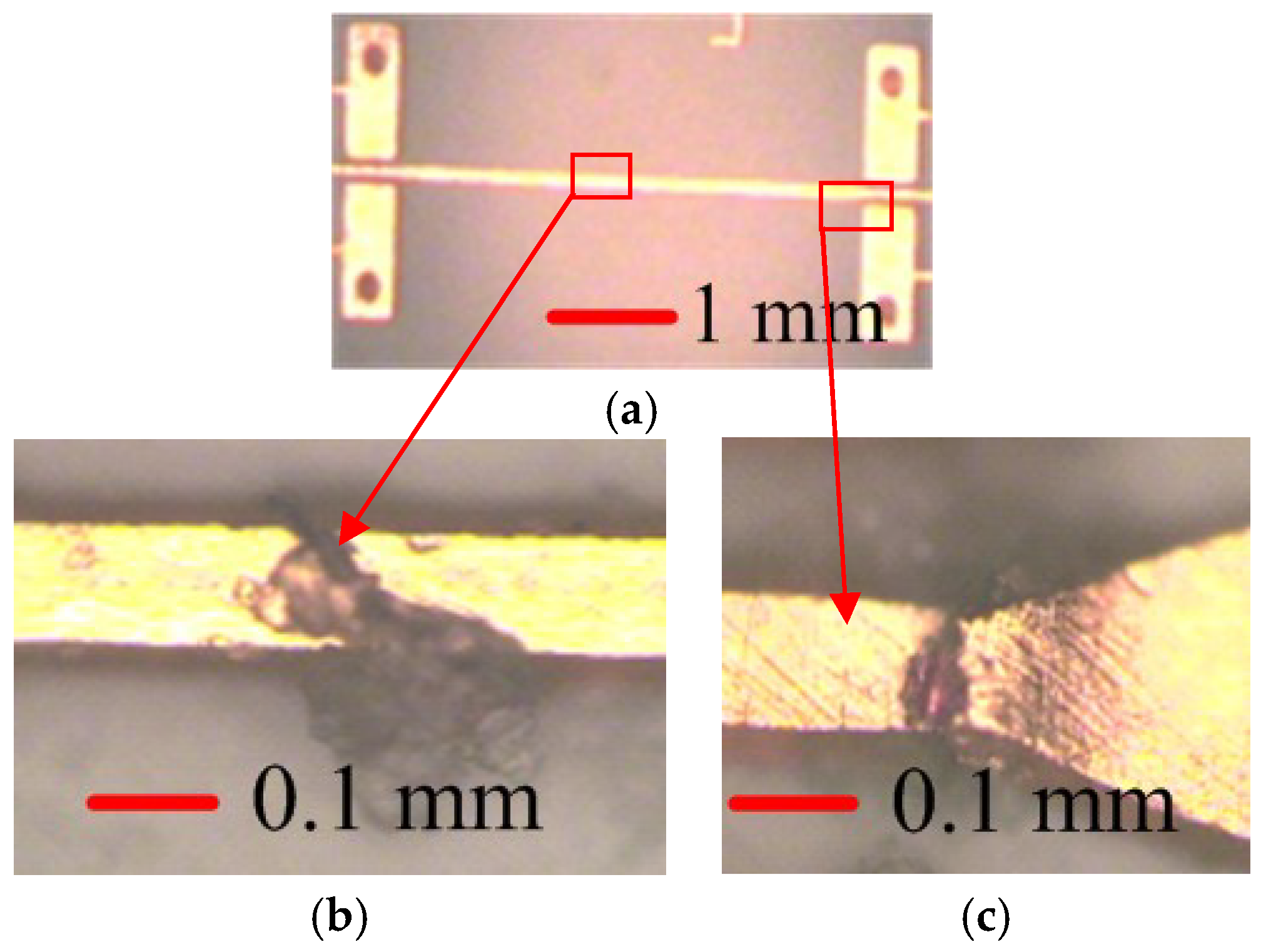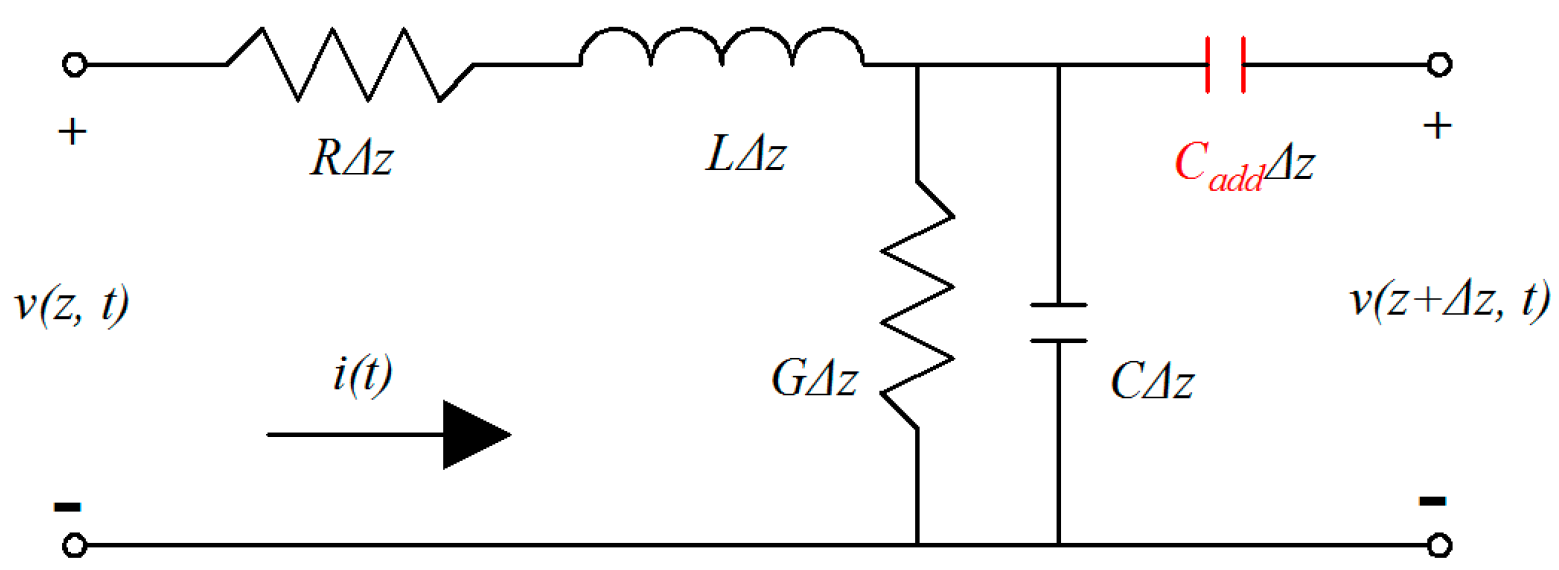Bending Limit Tests for Ultra-Thin Liquid Crystal Polymer Substrate Based on Flexible Microwave Components
Abstract
:1. Introduction
2. Device Design
3. Bending Limit Tests and Discussion
3.1. Results of Bending Limit Tests of the Microwave Components
3.2. Study and Discussion of the Failure Mechanism
4. Conclusions
Author Contributions
Funding
Conflicts of Interest
References
- Thompson, D.; Tantot, O.; Jallageas, H.; Ponchak, G.; Tentzeris, M.; Papapolmerou, J. Characterization of Liquid Crystal Polyer (LCP) Material and Transmission Lines on LCP Substrate From 30-110 GHz. IEEE Trans. Microw. Theory Tech. 2004, 52, 1343–1352. [Google Scholar] [CrossRef]
- Khan, W.T.; Morcillo, D.; Ulusoy, C.A.; Papapolymerou, J. Characterization of liquid crystal polymer from 110GHz to 170GHz. In Proceedings of the Radio and Wireless Symposium, Newport Beach, CA, USA, 19–23 January 2014. [Google Scholar]
- Zhang, X.; Kuylenstierna, D.; Liu, J.; Cae, P.; Andersson, C.; Morris, J.; Zirath, H. A compact V-band planar wideband bandpass filter based on Liquid Crystal Polymer substrates. In Proceedings of the 2nd Electronics System integration Technology Conference, Greenwich, UK, 1–4 September 2008. [Google Scholar]
- Ye, J.D.; Qu, D.X.; Zhong, X.J.; Zhou, Y.X. Design of X-band Band-pass Filter Using Hairpin Resonators and Tapped Feeding Line. In Proceedings of the Symposium on Computer Applications and Communications, Weihai, China, 26–27 July 2014. [Google Scholar]
- Cervera, F.J.; Hong, J.S. Compact Self-Packaged Dual-band Filter Using Multilayer Liquid Crystal Polymer Technology. IEEE Trans. Microw. Theory Tech. 2014, 62, 2618–2625. [Google Scholar] [CrossRef]
- Chlieh, O.L.; Khan, W.T.; Papapolymerou, J. L-band Tunable Microstrip Band-pass Filter on Multilayer Organic Substrate with Integrated Microfluidic Channel. In Proceedings of the IEEE MTT-S International Microwave Symposium, Tampa, FL, USA, 1–6 June 2014. [Google Scholar]
- Zhang, Y.F.; Shi, S.Y.; Martin, R.; Yao, P.; Shreve, K.; Prather, D.W. Multilayer Liquid Crystal Polymer Based RF Front-end Module for Millimeter Wave Imaging. In Proceedings of the IEEE Antennas and Propagation Society International Symposium, Memphis, TN, USA, 6–11 July 2014. [Google Scholar]
- Mamidanna, M.; Pham, A.V.; Montauti, F. Development of a Liquid Crystal Polymer Low Noise Amplifier Module at Ka-band. In Proceedings of the IEEE MTT-S Int. Microwave Sym, Tampa, FL, USA, 1–6 June 2014. [Google Scholar]
- Qiu, Y.J.; Jung, Y.H.; Lee, S.; Shih, T.Y.; Lee, J.H.; Xu, Y.H.; Lin, W.G.; Behdad, N.; Ma, Z.Q. Compact parylene-c-coated flexible antenna for WLAN and upper-band UWB applications. Electron. Lett. 2014, 50, 1782–1784. [Google Scholar] [CrossRef]
- Geise, A.; Strohmaier, U.; Jacob, A.F. Investigations of Transmission Lines and Resonant Structures on Flexed Liquid Crystal Polymer (LCP) Substrates up to 67 GHz. In Proceedings of the Microwave Conference, Rome, Italy, 29 September–1 October 2009. [Google Scholar]
- Kao, H.L.; Cho, C.L.; Dai, X.; Yeh, C.S.; Zhang, X.Y.; Chang, L.C.; Chiu, H.C. Hairpin Band-pass Filter on Liquid Crystal Polymer Substrate using Inkjet Printing Technology. In Proceedings of the IEEE MTT-S International Microwave Symposium Digest, Seattle, WA, USA, 2–7 June 2013. [Google Scholar]
- Kao, H.L.; Cho, C.L.; Chang, L.C. Inkjet-Printed Interdigital Coupled Line Filter on Liquid Crystal Polymer Substrate. IEEE Electron. Device Lett. 2013, 34, 1584–1586. [Google Scholar] [CrossRef]
- Kao, H.L.; Yeh, C.S.; Zhang, X.Y.; Cho, C.L.; Dai, X.; Wei, B.H.; Chang, L.C.; Chiu, H.C. Inkjet Printed Series-Fed Two-Dipole Antenna Comprising a Balun Filter on Liquid Crystal Polymer Substrate. IEEE Trans. Compon. Packag. Manuf. Technol. 2014, 4, 1228–1236. [Google Scholar]
- Lan, Y.; Xu, Y.H.; Wang, C.S.; Wen, Z.; Qiu, Y.J.; Mei, T.D.; Wu, Y.Q.; Xu, R.M. X-band Flexible Band-pass Filter Based on Ultra-thin Liquid Crystal Polymer Substrate. Electron. Lett. 2015, 51, 345–347. [Google Scholar] [CrossRef]
- Lan, Y.; Xu, Y.H.; Wang, C.S.; Wen, Z.; Qiu, Y.J.; Mei, T.D.; Wu, Y.Q.; Xu, R.M. Flexible Microwave Filters on Ultra Thin Liquid Crystal Polymer substrate. In Proceedings of the IEEE MTT-S International Microwave Symposium, Phoenix, AZ, USA, 17–22 May 2015. [Google Scholar]
- Dagdeviren, C.; Su, Y.W.; Joe, P.; Yona, R.; Liu, Y.H.; Kim, Y.S.; Huang, Y.A.; Damadoran, A.R.; Xia, J.; Martin, L.W.; et al. Conformable Amplified Lead Zirconate Titanate Sensors with Ehanced Piezoelectric Response for Cutaneous Pressure Monitoring. Nat. Commun. 2014, 5, 4496–4506. [Google Scholar] [CrossRef] [PubMed]
- Akinwande, D.; Petrone, N.; Hone, J. Two-dimensional flexible nanoelectronics. Nat. Commun. 2014, 5, 5678–5689. [Google Scholar] [CrossRef] [PubMed]
- Advanced Circuit Materials Division, Rogers Corporation. ULTRALAM®3000 Liquid Crystalline Polymer Circuit Material. Rogers, CT. 2014. Available online: http://www.rogerscorp.cn (accessed on 18 October 2018).
- Tsai, C.M.; Lee, S.Y.; Tsai, C.C. Performance of a Planar Filter Using a 0 Feed Structure. IEEE Trans. Microw. Theory Tech. 2002, 50, 2362–2367. [Google Scholar] [CrossRef]
- Pozar, D.M. Microwave Engineering, 3rd ed.; Publishing House of Electronics Industry: Beijing, China, 2005; Volume 2, pp. 42–43. [Google Scholar]
- Park, S.; Ahn, J.H.; Feng, X.; Wang, S.D.; Huang, Y.G.; Rogers, J.A. Theoretical and Experimental Studies of Bending of Inorganic Electronic Materials on Plastic Substrates. Adv. Funct. Mater. 2008, 18, 2673–2684. [Google Scholar] [CrossRef]





© 2018 by the authors. Licensee MDPI, Basel, Switzerland. This article is an open access article distributed under the terms and conditions of the Creative Commons Attribution (CC BY) license (http://creativecommons.org/licenses/by/4.0/).
Share and Cite
Lan, Y.; Xu, Y. Bending Limit Tests for Ultra-Thin Liquid Crystal Polymer Substrate Based on Flexible Microwave Components. Micromachines 2018, 9, 531. https://doi.org/10.3390/mi9100531
Lan Y, Xu Y. Bending Limit Tests for Ultra-Thin Liquid Crystal Polymer Substrate Based on Flexible Microwave Components. Micromachines. 2018; 9(10):531. https://doi.org/10.3390/mi9100531
Chicago/Turabian StyleLan, Yu, and Yuehang Xu. 2018. "Bending Limit Tests for Ultra-Thin Liquid Crystal Polymer Substrate Based on Flexible Microwave Components" Micromachines 9, no. 10: 531. https://doi.org/10.3390/mi9100531




